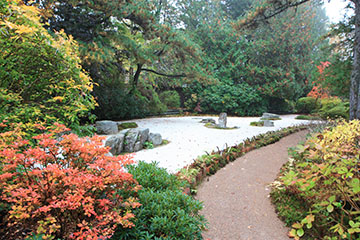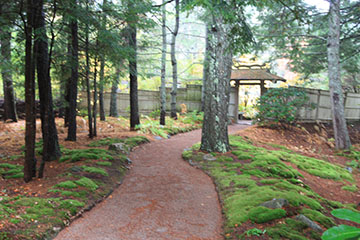Autumn 2016 Newsletter
| Gardening in Containers | Garden Inspirations | Our New York Adventure |
Gardening in Containers
Growing plants in containers creates the opportunity for developing exciting ornamental relationships between the plants, the pot and the garden. Container gardening also allows the gardener to grow plants in locations where there is no soil for traditional gardening or where environmental conditions, such as a sandy beach or the dense root zone beneath a tree might deter the growth of the plant.
Containers literally elevate their contents above the ground and put plants "on stage", where they can really show off their flowers and foliage. The container itself can be neutral in color or it can offer a colorful contrasts and complements. Try planting the silver-leafed Pulmonaria 'Majesty' in a deep-blue glazed jardiniere, and nestled it next to the chartreuse foliage of Hosta 'Gold Standard' for a striking focal point in the shade.
Weatherproof containers, planted with hardy perennials or woody shrubs, add year-round sculptural interest to the garden. There are many durable container materials to choose from: fiberglass, plastic, wood, lead, composite stone and stoneware pottery.
Large stoneware pottery, either glazed or unglazed, is a favorite of ours for furnishing the garden. Stoneware is a high-fired pottery in which the clay turns vitreous - to glass. Unlike soft earthenware, it doesn't absorb water. Stoneware pots will not break in winter if they are filled with a soil medium (with or without plants). Glazed stoneware containers add both sculptural form and a colorful spark to the bleak winter landscape.
Growing mediums for containers are usually best composed of artificial soils. Garden soils will compact and not provide the free water drainage that container plants need. Mixes can be made of a combination of peat moss, composted bark, sand and perlite. Commercially available mixes such as Pro Mix BX provide the right texture for water retention and drainage appropriate for most plants. However, these soil-less mixes must be supplemented with fertilizers. A combination of slow release (Osmocote) and a balanced liquid fertilizer (20-20-20) will promote good growth.
Durable containers can be planted seasonally with annuals or permanently with shrubs, trees or perennials. However, since container culture exposes the plant's root zone to a much colder winter temperatures than plants in the ground, some plants that are hardy when planted in the ground may not be root hardy in a container. Yet many evergreen shrubs, dwarf conifers, grasses and herbaceous perennials will survive these low winter temperatures above ground.
Attractive and hardy container specimens can be found among the many cultivars in the evergreen plant families of pine, Pinus; arborvitae, Thuja; yew, Taxus; falsecypress, Chamaecyparis; juniper, Juniperus; and spruce, Picea. Dwarf Alberta spruce, Picea glauca 'Conica'; mugo pine, Pinus mugo mugo; and Rheingold arborvitae, Thuja occidentalis 'Rheinhold' will grow for many years in a 24-inch diameter pot. Yews and falsecypress offer excellent shade tolerant container solutions.
The fragrantly foliaged bayberry, Myrica pensylvanica, is as sturdy in a container as it is sprawling in rocky cracks in ledges along the ocean. Bayberry's tolerance to drought and ability to fix its own nitrogen are ideal characteristics for container culture. Bayberry grows with nearly complete neglect in a container in the shade of a Norway maple by our garden shed. Ninebark, Physocarpus, is another very tough native shrub with attractive foliage for containers in sun or shade. Several ornamental grasses have proven to be root hardy for perennial container plantings. Blue oat grass, (Helictotrichon), variegated moor grass (Molinia) and feather-reed grass.
Calamagrostis are sun lovers. Blue oat grass, Helictotrichon sempervirens combined with dwarf baby's breath, Gypsophila repens, creeping over the edge is attractive for its blue foliage that also gives winter structure and interest. The beautiful chartreuse foliage of variegated moor grass, Molinia caerulea'Variegata', provides an accent in a container set on the edge of a mixed perennial border. The yellow foliage echoes golden daylilies and coreopsis. Molinia has proven hardy at the nursery (Zone 5) even in a shallow 18-inch diameter stoneware pan.
Cotinus coggygria 'Purpureus' offers a red foliage accent for full sun. Cotinus is a member of the same plant family as cut-leaf staghorn sumac, Rhus typhina 'Laciniata'. Both have hardy constitutions for container planting. Containers can be used to offer a good-looking solution to restrain the spreading habits of some plants. Blue dune grass, Lymus glaucus, is quick to spread by stolons. An old gardening trick is to plant it in a pot sunk in the ground. Thus tamed, its powder blue leaves provide a fabulous accent without overrunning the border. Try potting it up.
by Warren P. Leach
Garden Inspirations
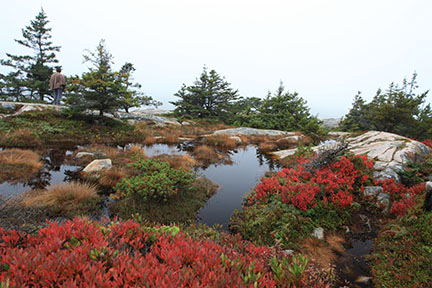 |
Schoodic Acadia National Park |
Gardens are essential to our humanity. I Couldn't agree more with this affirmative statement about gardens, creating gardens, embracing horticulture and cultivating ornamental plants. Gardening is innately part of me and probably many of you. It is always satisfying when one's innate belief is unequivocally corroborated, which Robert Harrison does in his thought-provoking GARDENS An Essay on the Human Condition. This insightful book came to me by serendipity, as a gift from someone for whom I was making a garden, in the heat of August! Harrison’s book is masterfully engaging -- exploring historical, philosophical, poetic and cultural aspects of a garden as being aborigine and a necessary part of our being.
One of his analysis about gardens particularly piqued me; “Conventional wisdom has it that gardens first arose either as a byproduct of agriculture or as a form of primitive agriculture;..." . Harrison delves into an ethbobotanical exploration. Although speculative, he asserts " gardens came first.” This is not a value judgment on vegetable gardening or one plant verses another, tomatoes over daylilies, although both are edible. The take-away for me is that the beauty and ornamental attributes of plants and their use in garden making are of an intrinsic value to our well-being. Plants and gardens give us pleasure and so much more!
Harrison’s manifest on the inherent importance of gardens was made even more poignant to me upon reflection of this years’ travels to our favorite gardens and arboreta. In particular, the Philadelphia Flower Show where Celebrating the Centenary of the inception of our National Parks was the theme with the tag-line ‘Find your National Park’. The show certainly had its highlights, perhaps for us it was an abstract montage in black and white plant materials, interpreting Ansel Adams’ iconic photographs of Sequoia National Park, Rocky Mountains National Park and others in the west. Celebrating a national unified consciousness of environmental awareness and ensuing stewardship of land and unique environments that our National Parks represent is certainly important. However, sustaining our environment and promoting stewardship of land and habitats and the practice of celebrating and making gardens are not mutually exclusive endeavors. Gardens that are sensitively designed and planted do promote a diversity of habitats, expand the food web and especially support a wealth of pollinators, ensuring that a variety of colorful birds, butterflies, bees and beneficial insects grace our gardens. The display gardens we have created over the past thirty years at Tranquil Lake Nursery follow this environmentally friendly paradigm. So, I suggest that you not only Find your National Park, but get in tune with your own nature, and make a garden.
After a busy and hot summer at Tranquil Lake Nursery, we finally traveled to Maine and Mt. Desert Island in October. Our first destination was to a garden, The Asticou Azalea Garden in Northeast Harbor, laid out as a Japanese Stroll Garden. Both Debi and I have deep spiritual connections to this garden. The fall coloration of Fothergilla major and Enkianthus campanulatus was vibrant, even in an overcast mist. The falling leaves of the katsura tree (Cercidiphyllum japonica) perfumed the air with the sweet scent of caramelized sugar. The garden is remarkable not only for creating captivating sequences of beauty but for it’s very being. It is a ‘garden phoenix’, like the mythical bird rising from the ashes of its predecessor, Asticou arose from the dismantling of Beatrix Farrand’s Reef Point Estate.
Farrand’s extensive collection of Ericaceous plants: Azaleas, Rhododendrons, Enkianthus, Calluna & Erica, as well as a diversity of ornamental trees and shrubs make up this remarkable garden. In 1956, all of the plants, including mature specimens, were carefully transplanted from her home in Bar Harbor to Northeast Harbor by garden enthusiasts and benefactors, who too felt that gardens are essential to our humanity. Both Asticou Azalea Garden and nearby Thuja Garden (also created as a repository of Reef Point plants) are manifestations of love of horticulture and perpetuating Beatrix Farrand’s dream of promoting horticulture and garden making to future generations.
For fifty-five of my sixty year, I have cultivated a passion for plants and devotion to making gardens. I am grateful that my mother instilled and nurtured this love of gardening, teaching me from a very early age to sow seeds, and tend annuals, perennials and grow vegetables. Gardening was not just her outside avocation, plants filled the windowsills of our house: African violets in north windows, begonias, geraniums, Christmas cactus, kalenchoe and other succulents occupied other niches. I grew up inspired by the gardens my mother cultivated as well as a deep awareness of genius loci, spirit of the site, of our rural farm setting and the scenic Maine landscapes from Penobscot Bay to Frenchman’s Bay. The grandeur of Acadia with its incredible wild beauty juxtaposed with the extraordinary gardens on Mt. Desert Island is an essential part of me and infuses my garden making.
It’s mid-November and we are still busy making and planting gardens. Even in this late season, gardens can be a spectacle of color and beauty. Although last April’s sensation of seeing drifts of hundreds-of-thousands of golden Narcissus ‘Tete a Tete’ blooming at Longwood Gardens is still in my mind’s eye, I am now enthralled with the masses of glowing yellow blooms of our native witch hazel (Hamamelis virginiana). The yellow, quill-like flowers embellish every branch and twig. Aster tataricus has shrugged off multiple frosts and adds a complement of blue to the yellow witch hazels. These charming late blooms are enhanced even more by a blaze of yellow, orange, red and bronze foliage. The leaves of the Asian spicebush (Lindera glauca var. salicifolia) have turned pumpkin-orange, and will later turn tan persisting through winter’s snow. The combination of Lindera with the evergreen leaf form of sweetbay magnolia (Magnolia virginiana ‘Henry Hicks’) and the red berries of winterberry holly (Ilex verticillata ‘Winter Red’) and red chokeberry (Aronia arbutifolia ‘Brilliantissima’) will sustain the garden through the winter. As if a garden full of colorful fruits, foliage and twigs were not enough, more flowers are yet to bloom! The vernal witch hazel (Hamamelis vernalis), native to the Ozarks comes into blossom in late December and early January. An alluring cultivar is ‘Amethyst’ (Hamamelis vernalis ‘Amethyst’) with fragrant amethyst-colored flowers lasting in bloom for six weeks or more in the winter. The Asian witch hazels bring us the chorus of yellow, orange and red blooms throughout the winter.
It has been my good fortune, for more than thirty years at Tranquil Lake Nursery, to professional engage in this wonderful practice of horticulture and making gardens. This deep love of gardening is blessed by the long lasting and rewarding relationships developed by collaboratively creating gardens with enthusiastic and passionate clients. Ten years ago, an opportunity arose to make a garden for untold families whose lives have been upended while they cope with a child fighting cancer. Sherry’s House and Why Me is a sanctuary in Worcester for these families from across the country, where they stay for free while obtaining necessary medical services in Worcester and Boston. A garden was considered essential for their humanity. Jason's Healing Garden is the name of the garden that we made, with the help of many others, including a crew of Worcester Fire Fighters on the first day of planting. For ten years, we have continued to give our labor, materials and a diversity of plants to make what gardens are best at being, a refuge, a beautiful space luxuriant with plants that offer pleasure. Colorful and fragrant flowers offers an extended season of bloom, augmented with vibrant fruit, bright twigs and foliage to provide year-round beauty. I am thankful that Jason's Healing Garden gives joy to those in need. 'Gardens are essential for our Humanity".
Warren Leach
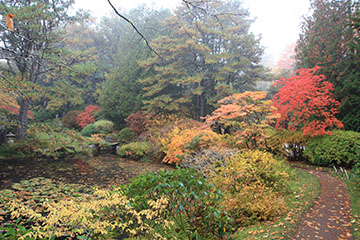 |
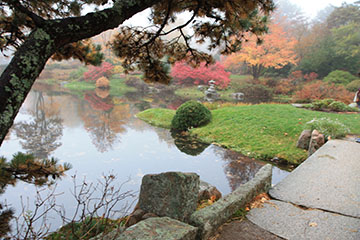 |
Asticou Azalea Garden, Northeast Harbor, Maine |
Asticou Azalea Garden, Northeast Harbor, Maine |
|
|
Asticou Azalea Garden, Northeast Harbor, Maine |
Asticou Azalea Garden, Northeast Harbor, Maine |
|
|
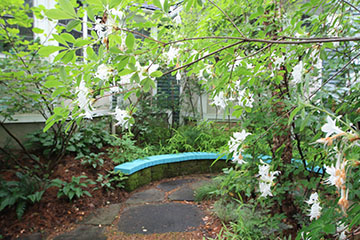 |
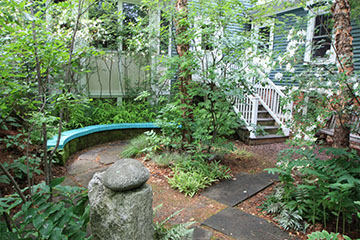 |
Sherry's House Worcester |
Sherry's House Worcester |
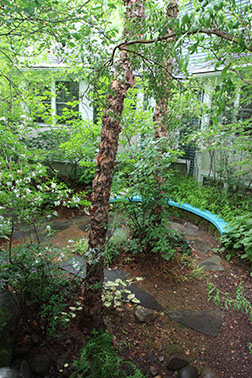 |
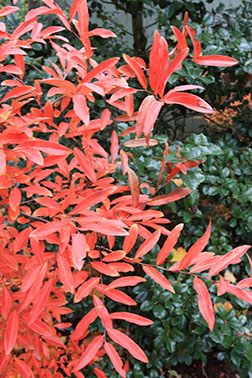 |
Sherry's House Worcester |
Lindera glauca var. salicifolia |
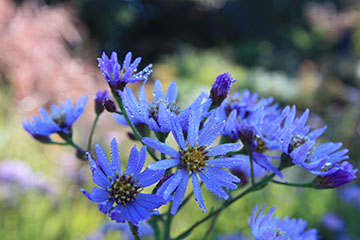 |
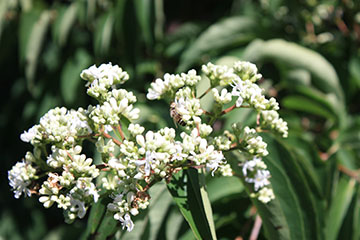 |
Aster tataricus |
Heptacodium miconioides |
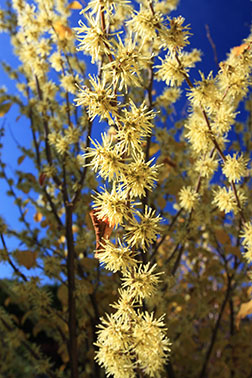 |
Native Witch Hazel Hamamelis virginiana |
Our New York Adventure
It ‘s the autumnal equinox and I’m even more excited and passionate for ornamental horticulture and making gardens.
Every so often a catalyst triggers an epiphany. For me there were two recent inspirations. The first was an insightful mind expanding book, "Gardens An Essay on the Human Condition" by Robert Pogue Harrison. In this book, Harrison explores
gardens, concluding they existed before agriculture.
Then, this past Sunday, we delivered daylilies to the Central Park Conservancy in New York City. We spent a very full day exploring The Conservancy Garden at Central Park, the High Line and one of my favorite gardens -- NYBG Wave Hill Botanic Garden on the Hudson. It was a superb finale to a day full of trees, shrubs, grasses, annuals, tender perennials and amazing colorful horticultural compositions. Here a just few images.
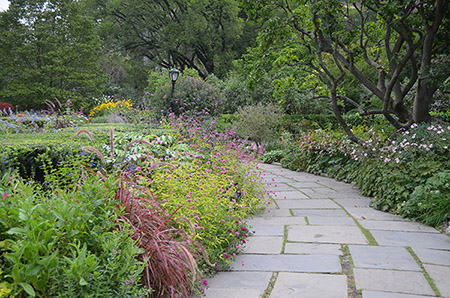 |
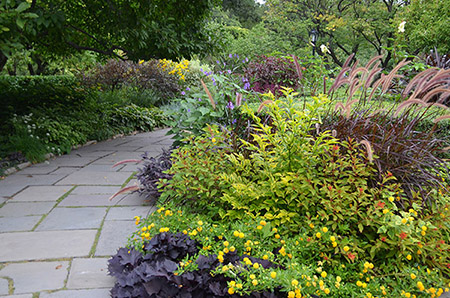 |
Central Park Conservancy Garden Anemones, Gomphrena, Pennisetum and other annuals |
Central Park Conservancy Garden Pennisetum, lantana, tender perennials and annuals |
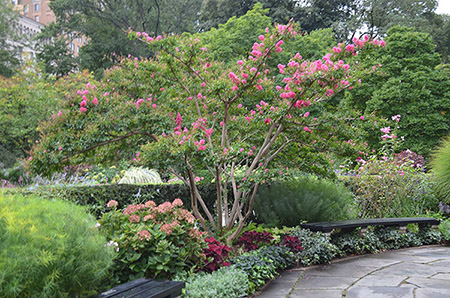 |
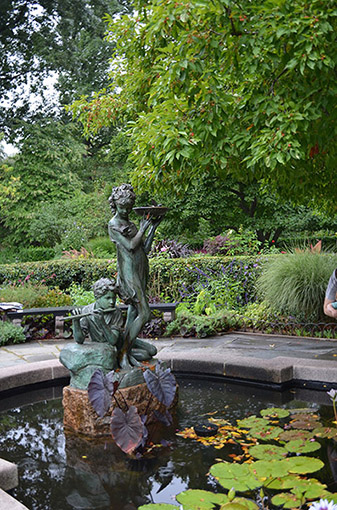 |
Central Park Conservancy Garden Crape Myrtle, Amsonia, Roses and Annuals |
Central Park Conservancy Garden Water Garden dedicated to Francis Hodgson Burnett |
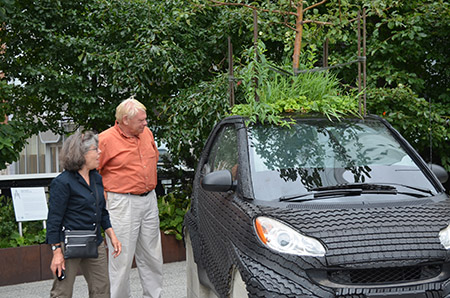 |
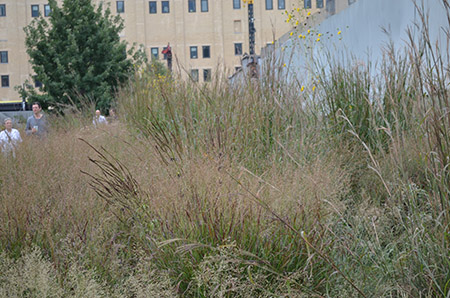 |
The High Line Warren and Diane and the tread car planter |
The High Line Grasslands |
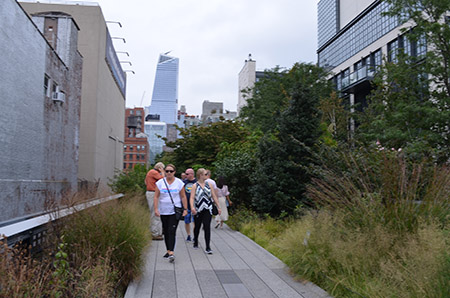 |
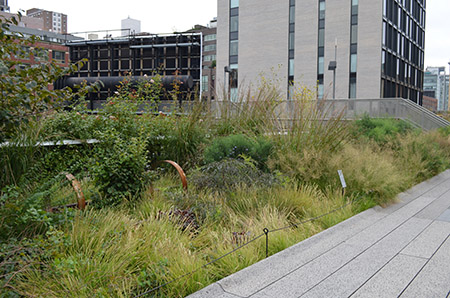 |
The High Line One of the narrow walkways |
The High Line Meadowlands |
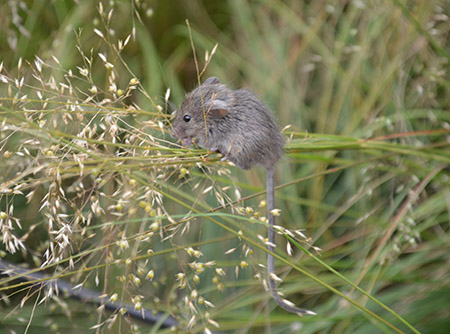 |
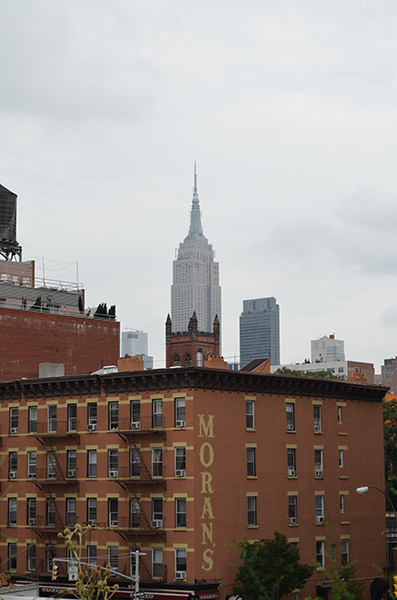 |
The High Line A baby mouse feeding on grasses. |
View of the Empire State Building from the High Line |
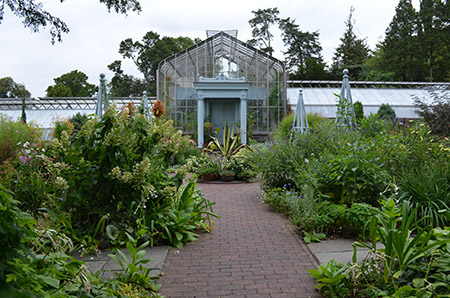 |
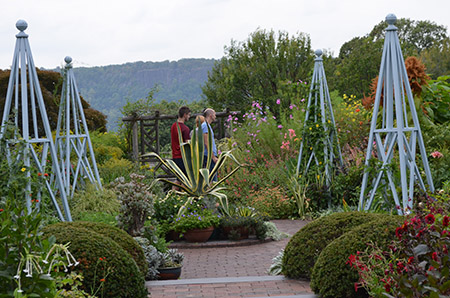 |
Wave Hill Botanic Garden Conservatory Garden filled with annuals & tender perennials |
Wave Hill Botanic Garden Conservatory Garden filled with annuals & tender perennials |
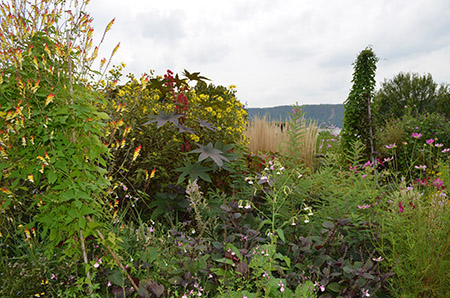 |
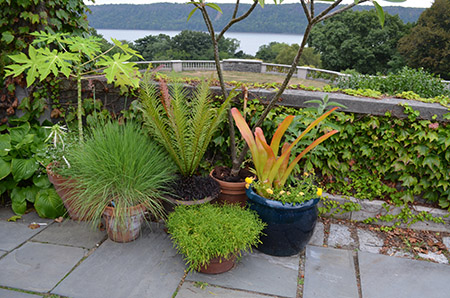 |
Wave Hill Botanic Garden Conservatory Gardens |
Wave Hill Botanic Garden View of the Hudson River and the Pallisades |
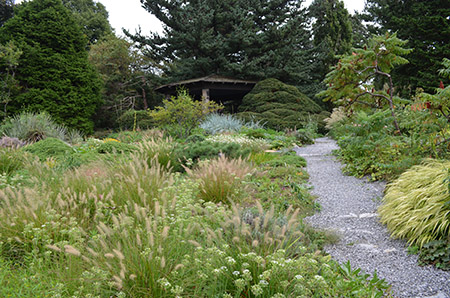 |
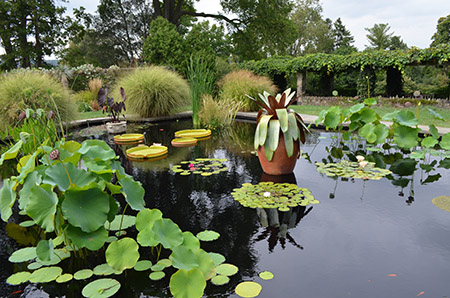 |
Wave Hill Botanic Garden Meadow Garden |
Wave Hill Botanic Garden Water Garden |
by Warren Leach, Landscape Horticulturist and owner of Tranquil Lake Nursery, Rehoboth, MA.

